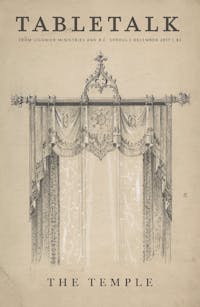
Request your free, three-month trial to Tabletalk magazine. You’ll receive the print issue monthly and gain immediate digital access to decades of archives. This trial is risk-free. No credit card required.
Try Tabletalk NowAlready receive Tabletalk magazine every month?
Verify your email address to gain unlimited access.
As Israelite worshipers entered the courtyards of the tabernacle and the temple, various sights, sounds, and smells assaulted them. Out of the constant activity of the priests as they ministered before the Lord, an unmistakable reality must have struck the participants: the institution of sacrifice was a messy enterprise. Sin had created a breach in mankind’s relationship with God and brought moral defilement, symbolized vividly in the intermingling of blood and dirt on the priests’ garments and bodies.
Yet, in the midst of the courtyards, the Holy One of Israel stationed instruments by which Aaron and his descendants might ceremonially cleanse and consecrate themselves as they represented Israel in the most fundamental and important component of human existence: worship. These vessels were the bronze basin of the tabernacle and the molten sea of the temple.
The book of Exodus records sparse details concerning the construction of the bronze basin (Ex. 30:17–21). The Lord commissions Moses to manufacture the vessel and its stand from bronze, but He does not prescribe dimensions for the basin. Instead, He emphasizes its location and function: in a vestibule between the tabernacle and the altar, to be used by Aaron and his sons for washing their hands and feet before entering the tent or ministering at the altar.
A warning follows: “They shall wash their hands and their feet, so that they may not die” (v. 21). This injunction reveals the primary purpose of the basin. The altar and the tent of meeting serve as the nexus through which the priests—and by virtue of their mediation, the entirety of Israel—enter into the presence of a holy God. In His presence, only two options emerge: death from defilement or worship through purity. Through the washing of water, the Lord provided renewable means by which the priests could undergo ritual purification so that they might minister in His presence.
While the form of the bronze basin underwent alterations befitting the glory of the temple on Mount Zion, its primary function as a means for ritual purification remained unchanged. Following instructions revealed to David (1 Chron. 28:19), Solomon cast a monumental bronze structure: the molten sea. A basin more than seven feet deep, with a diameter of fifteen feet, and holding more than ten thousand gallons of water, this receptacle featured a brim “like the flower of a lily” and two encircling rows of gourds (1 Kings 7:23–26). Four sets of three bronze oxen each supported the sea, each set facing toward a different direction of the compass.
The biblical authors again focus less on details and more on symbolism and purpose. Like a wild ox (Num. 24:8), the Lord, “majestic in holiness,” had trampled all physical and metaphysical enemies, established His terrestrial sanctuary on Zion (Ex. 15:13, 17), and prescribed regulations for His worship. As witnesses marveled at the power and purity of God’s holiness represented by the molten sea, many people must have echoed David’s words from Psalm 15: “O Lord, who shall sojourn in your tent? Who shall dwell on your holy hill?” (v. 1).

David’s response to his own question—“He who walks blamelessly and does what is right and speaks truth in his heart” (v. 2)—demonstrates that the basin offered more than ordinary rinsing. They signaled a greater reality: entry into God’s presence demanded moral purity. The Lord’s provision of a purification ritual consecrated Aaron and his descendants for service but did not purge them of their sin. On the contrary, their constant washing emphasized their defilement, their inability to overcome it, and God’s forbearance of punishment for their sins (Rom. 3:25) until the time when He would commission another high priest in the likeness of Melchizedek, one “holy, innocent, unstained, separated from sinners” (Heb. 7:26), to deal with defilement. This blameless High Priest, Jesus,
gave himself up for her [the church], that he might sanctify her, having cleansed her by the washing of water with the word, so that he might present the church to himself in splendor, without spot or wrinkle or any such thing, that she might be holy and without blemish. (Eph. 5:25–27)
The once-and-for-all washing—signified by baptism—occurs as defiled sinners repent of their sins, in faith receive God’s promises fulfilled in Jesus and proclaimed in His Word, and become joined to Him. Through this union, believers break with their old lives and begin a process of sanctification in which they take on the qualities of their Savior, who will ensure its completion and a place for them forever in the presence of a holy God.
